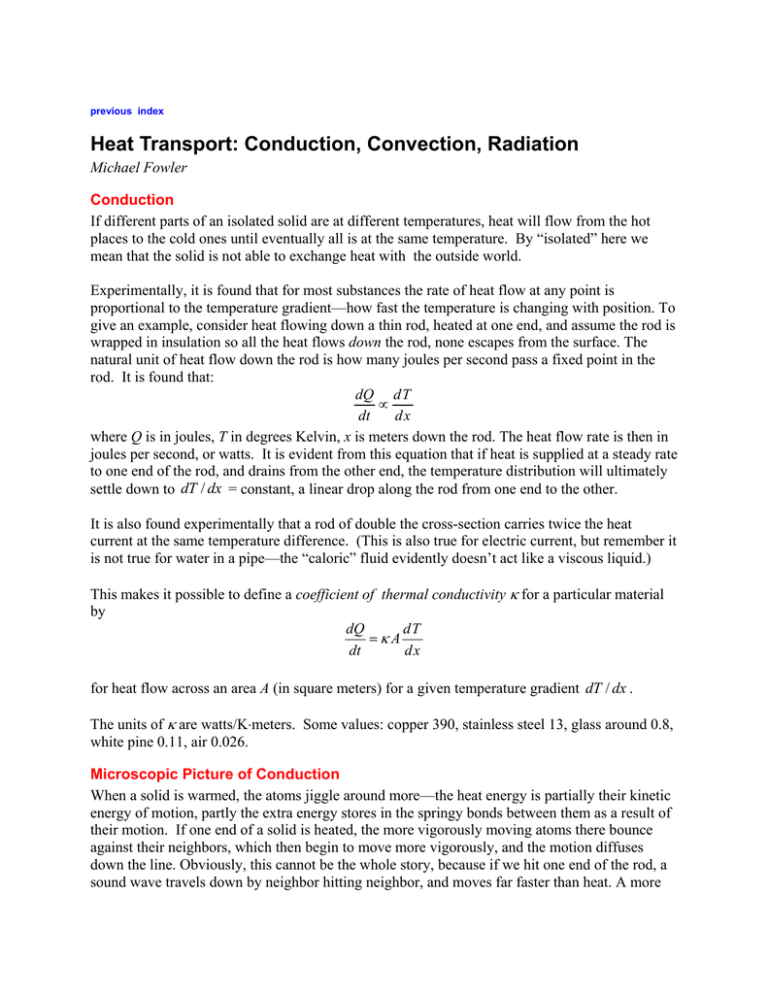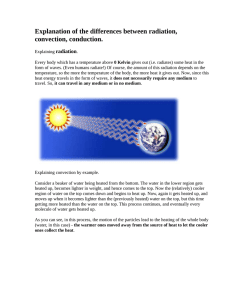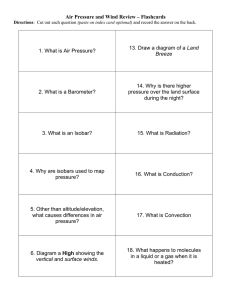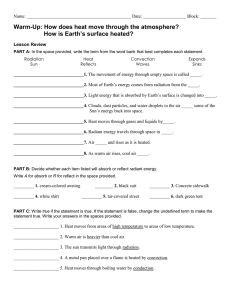Heat Transport: Conduction, Convection, Radiation
advertisement

previous index Heat Transport: Conduction, Convection, Radiation Michael Fowler Conduction If different parts of an isolated solid are at different temperatures, heat will flow from the hot places to the cold ones until eventually all is at the same temperature. By “isolated” here we mean that the solid is not able to exchange heat with the outside world. Experimentally, it is found that for most substances the rate of heat flow at any point is proportional to the temperature gradient—how fast the temperature is changing with position. To give an example, consider heat flowing down a thin rod, heated at one end, and assume the rod is wrapped in insulation so all the heat flows down the rod, none escapes from the surface. The natural unit of heat flow down the rod is how many joules per second pass a fixed point in the rod. It is found that: dQ dT ∝ dt dx where Q is in joules, T in degrees Kelvin, x is meters down the rod. The heat flow rate is then in joules per second, or watts. It is evident from this equation that if heat is supplied at a steady rate to one end of the rod, and drains from the other end, the temperature distribution will ultimately settle down to dT / dx = constant, a linear drop along the rod from one end to the other. It is also found experimentally that a rod of double the cross-section carries twice the heat current at the same temperature difference. (This is also true for electric current, but remember it is not true for water in a pipe—the “caloric” fluid evidently doesn’t act like a viscous liquid.) This makes it possible to define a coefficient of thermal conductivity κ for a particular material by dQ dT =κA dt dx for heat flow across an area A (in square meters) for a given temperature gradient dT / dx . The units of κ are watts/K⋅meters. Some values: copper 390, stainless steel 13, glass around 0.8, white pine 0.11, air 0.026. Microscopic Picture of Conduction When a solid is warmed, the atoms jiggle around more—the heat energy is partially their kinetic energy of motion, partly the extra energy stores in the springy bonds between them as a result of their motion. If one end of a solid is heated, the more vigorously moving atoms there bounce against their neighbors, which then begin to move more vigorously, and the motion diffuses down the line. Obviously, this cannot be the whole story, because if we hit one end of the rod, a sound wave travels down by neighbor hitting neighbor, and moves far faster than heat. A more 2 accurate picture (for a nonmetal) is that when one end is heated, tiny sound waves (called phonons) are generated by the fast moving atoms near the surface. these phonons travel into the solid at the speed of sound, but, unlike the massive compression wave when the end of the rod is hit, these phonons bounce off impurities or imperfections in the solid and follow random paths, only a few tens of atomic spaces between hits, typically. This, then is very like the diffusion of a molecule in a gas we studied earlier, and it takes several minutes for heat to make its way through, say, half a centimeter of glass. The picture is different for metals: the electrons which conduct electricity so efficiently do the same for heat. However, heat transport by electrons cannot be understood without quantum mechanics: Pauli’s Exclusion Principle means only about 1% of the electrons take part in the heat conduction, but it also means that they travel far faster. The thing to remember at this stage is that the electrons carry the heat, phonons do too, but make a negligible contribution. As you might expect, good conductors of electricity are also good conductors of heat. This is why copper is used in saucepans (also, it doesn’t corrode too badly). Conductivity in liquids and gases can be measured—but usually heat transport in fluids is dominated by convection, see below. Exceptions are, for example, a fluid heated from above, or a pond below 4 degrees Celsius being cooled from above on a winter night. American Units In the real world out there, the units are different. Heat flow (in construction jobs, for example) is measures in BTU’s per hour, temperature gradients in degrees Fahrenheit per inch thickness and cross-section area in square feet! The R-value of “thermal resistance” is the inverse of the thermal conductivity. For one square foot of material, one inch thick, R relates the heat current to the temperature drop by an Ohm’s Law equation ΔT = IR. Different areas and thicknesses scale in the obvious way. For a wall made of layers of different materials, the R-values just add. Convection Convection is gravitationally-induced heat transport, driven by the expansion of a fluid on heating. The hot expanded fluid has lower density, so will rise to the top of colder, and therefore denser, fluid. The simplest example is water in a kettle heated from below: hot water will rise in a central column, spread through the top layer, cooling, then flow back down around the outside. The pattern becomes more complicated if a fluid is being heated over a large area, with no obvious center. Convection cells can arise, each having a pattern like that in the kettle, the cells in a hexagonal pattern. This can happen in weather: a storm can be such a cell. However, many patterns are possible: the fluid mechanics is extremely complex. One important example of convection currents is inside the earth. Such currents deep inside are believed drive the surface movement of plates, causing earthquakes, tsunamis, etc. Radiation Heat from the sun reaches us as radiation, much of it visible light, the rest similar electromagnetic waves but at wavelengths our eyes are not sensitive to. All bodies not at absolute zero temperature radiate, at room temperature the radiation is in the infrared, wavelengths longer than those of the visible spectrum. Microscopically, the radiation comes about because the oscillating ions and electrons in a warm solid are accelerating electric charges, and as you will find next semester, such charges radiate. Different substances radiate with different efficiencies, those that radiate better also absorb incoming radiation better. A perfect absorber is called a 3 black body (such perfection is not found in nature, but some things are close). This, then, is also a perfect radiator. It was found experimentally that for a perfect black body at an even temperature, the radiant energy output in watts per square meter of surface went as the fourth power of the absolute temperature: P = σT 4 P being power per square meter, σ is Stefan’s constant, 5.67 × 10−8 Watts/sq.m./K4. For a given T, the radiant power peaks at a certain wavelength, λmaxT = constant . This was well established: on heating a piece of metal, say, such as turning a dimmer on an ordinary light bulb, the first visible radiation is in the red, and an extremely hot object becomes white or even bluish. However, this was theoretically incomprehensible without quantum mechanics, and in fact the mystery of black body radiation led Planck to the first formulation of the idea of the quantum. My lecture on black body radiation can be found here. Exercises: 1. Estimate the sun’s surface temperature knowing the heat received here is about one kilowatt per square meter. 2. Estimate the rate of heat loss from a naked body at skin temperature 33 degrees C in a room with walls at 20 degrees C. (It would be zero for a body at 20 degrees!) previous index




